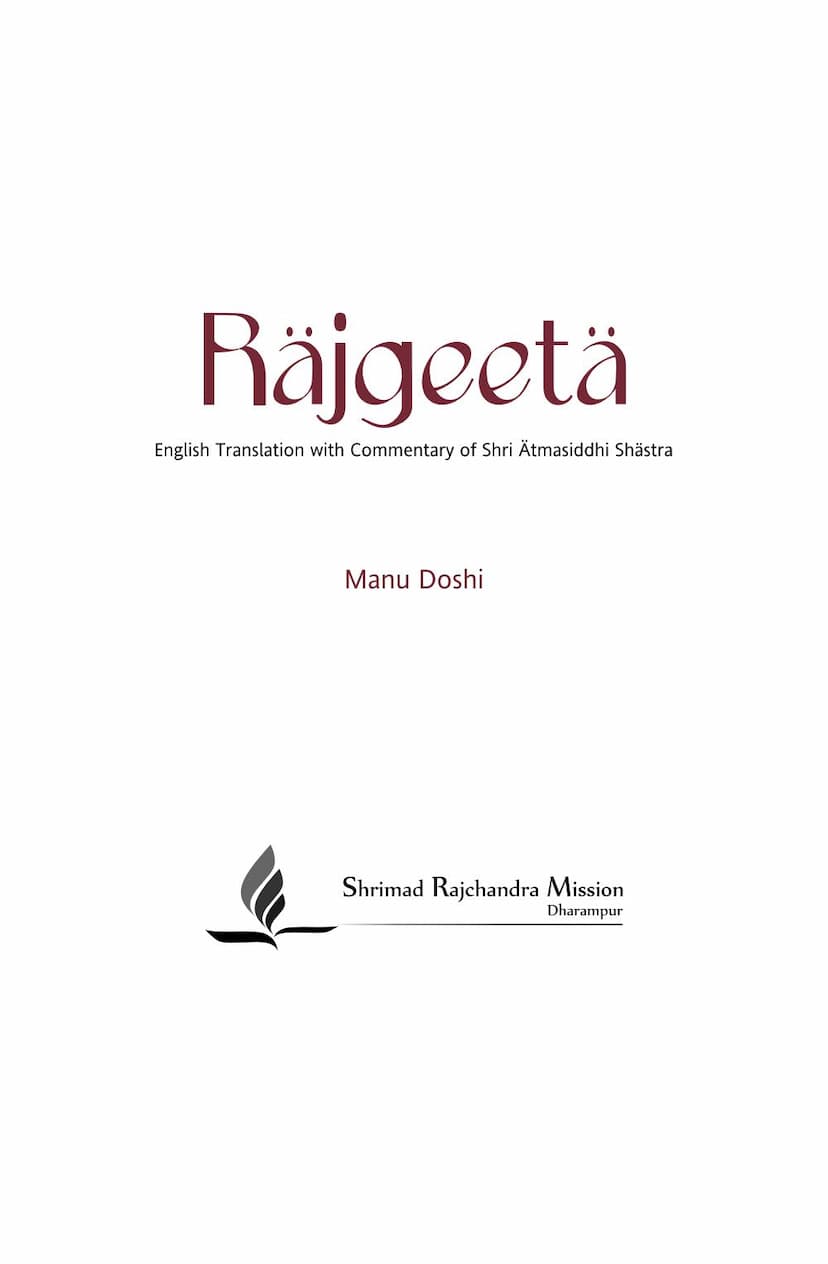Rajgeeta English Translation And Comentry On Atmasiddhi Shastra
Added to library: September 2, 2025

Summary
The book "Rajgeeta: English Translation with Commentary of Shri Atmasiddhi Shastra" by Shrimad Rajchandra and translated and commented on by Manu Doshi, published by Shrimad Rajchandra Mission, is a profound exposition of Jain spiritual philosophy. The central text, Shri Atmasiddhi Shastra, is a concise yet deeply philosophical scripture composed by Shrimad Rajchandraji, a spiritual luminary of the late 19th century.
The book is structured to guide truth-seekers through a rigorous inquiry into the nature of the self and the path to liberation. It begins with a Prologue that introduces Shrimad Rajchandraji as a spiritual philosopher of immense caliber, noting his early self-realization, his unique mnemonic abilities (Shatavadhani), and his profound influence on Mahatma Gandhi. The prologue also highlights the pivotal role of Shrimadji's devotees like Ambälälbhäi, Saubhägyabhäi, and Laghuräjswämi in bringing forth his teachings, including the Atmasiddhi Shastra itself, which was composed in a remarkably short time.
The core of the book is dedicated to the Shri Atmasiddhi Shastra, presented in a question-and-answer format between a sincere pupil and an enlightened Guru. The pupil's journey of understanding is meticulously laid out through 18 Chapters, covering six fundamental principles (Shath Pad):
- Existence of Soul: The pupil questions the existence of the soul, as it is not visible, does not have a perceivable form, and cannot be experienced through senses. The Guru clarifies that the soul is distinct from the body, senses, and breath, and its existence is evidenced by consciousness, the seer, the knower, and the experiencer within. The Guru uses analogies like a sword and its sheath to illustrate the soul's inseparable yet distinct nature from the body.
- Everlastingness of Soul: The pupil doubts the soul's eternity, suggesting it might arise with the body and perish with it, or that everything is transitory. The Guru explains that while the body is a temporary composition, the soul is an eternal substance. He elaborates on the concept of states (Paryäy) versus substance (Dravya), explaining that the soul undergoes changes in its states (like childhood, adulthood, old age) but its essential nature remains eternal. The Guru also points to the consistent traits observed from birth in various beings as evidence of past lives and, therefore, the soul's continuity.
- Soul as Kartä (Doer/Agent): The pupil questions how the soul, if pure and eternal, becomes the doer of Karma. The Guru clarifies that Karma arises not from the soul's intrinsic nature but from its inclination towards craving and aversion when encountering situations. These inclinations, termed Bhäv Karma, attract material Karma (Dravya Karma). The Guru emphasizes that while Karma particles are lifeless, the soul's consciousness and its "inducing" capability are the driving forces. He refutes the idea of an external God or Nature being responsible for Karma, attributing the act of becoming Kartä to the soul's own unvigilant state.
- Consequences of Karma: The pupil questions how Karma, being lifeless, can extend consequences without an intelligent agency like God. The Guru explains that Karma, like poison or nectar, has inherent properties that yield results irrespective of consciousness. The soul, by its nature of Karma acquisition, becomes subject to these consequences. He illustrates this with the observed diversity in life forms and circumstances, arguing that these arise from previous wholesome or unwholesome Karmas, as nothing happens without a cause. He asserts that God is not needed as a dispenser of justice; Karma fructifies by its own nature.
- Liberation: The pupil, convinced about Karma and its consequences, questions the possibility of liberation, given the soul's continuous involvement in acquiring Karma. He points out that wholesome Karmas lead to pleasant states (heaven) and unwholesome ones to unpleasant states (hell), and in neither state is the soul Karmaless. The Guru explains that liberation is achieved by ceasing the cycle of Karma acquisition. This is done by withdrawing from both attachment (craving) and aversion (resentment) towards worldly situations. True liberation is the state of total detachment and the realization of the soul's inherent pure, blissful, and conscious nature.
- Path and Means of Liberation: The pupil, now fully understanding the goal of liberation, seeks the path to achieve it, questioning the multiplicity of religious paths and the difficulty of eradicating long-standing Karma. The Guru outlines the path as the eradication of causes of bondage, primarily the three principal knots of craving, aversion, and ignorance. He emphasizes the role of enlightenment (Bodh) and detachment (Vitarägtä) in overcoming deluding Karma. The path involves gaining right perception (Samyakdarshan), followed by right knowledge (Samyakjnān) and right conduct (Samyakchäritra), ultimately leading to omniscience and liberation. The Guru stresses that various schools of thought are covered within these six Fundamentals, and their consistent practice leads to the ultimate goal.
The book also includes "Chha Padano Patra" (The Letter of Six Fundamentals), an appendix that reiterates the six fundamental principles with further elaboration and philosophical depth, as explained by Shrimad Rajchandraji in a letter.
The publication is presented by Shrimad Rajchandra Mission Dharampur, with a foreword by Pujya Gurudevshri Rakeshbhai, who is also the founder of the Mission. The book is dedicated to truth seekers and aims to spread Shrimad Rajchandraji's invaluable teachings to a global audience. It highlights the mission's activities in spiritual growth, youth development, children's education, and seva initiatives, underscoring the commitment to realizing one's True Self and serving others selflessly. The publication also lists other books and audio-visual resources available from the Mission.
In essence, "Rajgeeta" serves as a comprehensive guide for anyone seeking spiritual awakening, offering a structured and logical approach to understanding the self, the nature of reality, and the path to ultimate freedom within the framework of Jain philosophy.